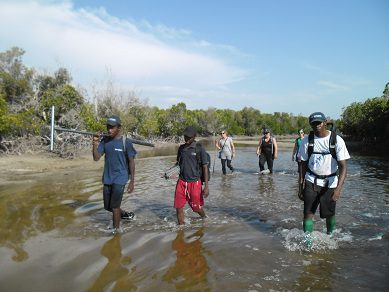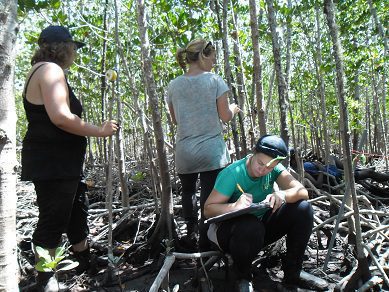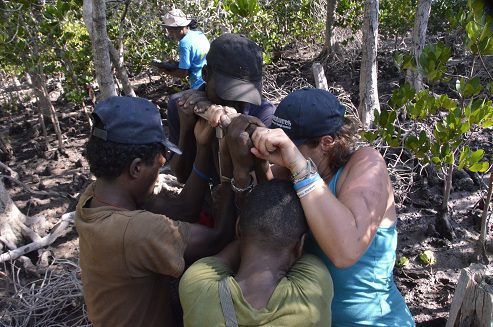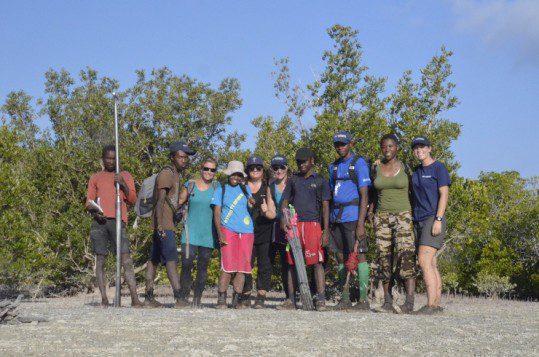Mere hours after the annual conference for Blue Ventures had ended in Andavadoaka, our eighth, and final, expedition of 2014 began! Typically, when the cars arrive on-site, volunteers have the chance to unpack, shower and get acquainted with their new ‘6-week home’, but this time was a bit different. Running on adrenaline from a high-intensity, jam-packed, information-loaded and all-around-wonderful weekend, I couldn’t possibly let the learning end there. After meeting the new faces and absorbing a huge amount of Blue Ventures project-based information, I thought what better way to learn more than to join a project in the field!

Wading through the mud…
[Tweet “What better way to learn than to join a project in the field!”]
We travelled to the small village of Tampolove by our trusty Land Cruiser with ‘we’d-soon-find out-what-they-were-for’ mangrove tools, music only someone living in Andava could love, and the always entertaining Blue Forests Team. Upon arrival, we dropped our stuff at Chez Richard’s, grabbed some food and headed straight to the mangroves for a three hour methodology tutorial and a plot set-up. Before sunset, we returned, learnt how to enter data (because with all great science comes great data entry), had some dinner and got some sleep before what was due to be a long, hot day ahead.
The following morning, after the staple breakfast of boko-boko and coffee, we set off with a packed lunch of rice and beans, loads of water, and a ridiculous mangrove trekking outfit that only a mother (or those working in the field) could love. We met the co-marine and travelled to Vatoavo – a village even smaller than Tampolove, but what was looking to be a promising Mangrove goldmine. We trekked through water and knee deep mud into the mangrove forest, watching hundreds of little mangrove crabs scurry off at low tide. Already muddy, sweaty and thirsty, we reached what the Blue Forests team had deemed, through a pre-field check, our first plot. Here we set-up a mangrove plot (a 10m x 10m area, surrounded by a 20m x 20m ‘large’ plot and started to sample every mangrove we could find within it.

Diligently recording the information
Under the direction of Lalao Agriette (the Mangrove goddess), we measured the circumference of every mangrove tree (some plots contained over 300 trees!) at a height of approximately 1.3m, and if it was greater than in 7.8cm in the small plot and greater than 15.4cm in the large plot, then we would record the species, its formation, whether it was dead or alive, and its approximate height, using a transponder and hypsometer.
[pull_quote_left]We then extracted six 5 cm sub samples, from pre-determined depths, and put them into small tin cans which would later be sent to a lab in Tana for carbon testing.[/pull_quote_left] Cecelin and Sylvia (two long-time Blue Forest team members) counted and recorded any regenerating trees within 1m x 1m corners of the plot, as well as any stumps that were within. Dolce was in charge of recording canopy cover by standing at the plot centre, as well as each corner, with a densitometer and recording the percentage of the plot not occupied by canopies. Lastly, Zo and I took care of soil samples by forcefully pushing a soil corer 1.5m into the ground using every bit of strength we had (normally a task that consisted of help from up to 6 people and myself jumping up and down on the top), twisting it three times and then gently pulling it out of the soil to retrieve samples. We then extracted six 5cm sub samples, from pre-determined depths, and put them into small tin cans which would later be sent to a lab in Tana for carbon testing.

Coring samples is not easy work!
Each plot would take approximately three hours, as we needed to be precise and accurate with the data collected. All information, data and other details (like time, date, weather, etc) were recorded on field sheets. We completed three plots that first day, in time to return back to Tampolove by sunset; indulged in freshly roasted peanuts, a shower, and followed by data entry – by 8.30pm, we were more than ready for bed.
We participated in this for three days (of the 10 day project) and although it was a lot of work in a challenging environment, it was a great opportunity to see the work of another project and to have a small experience of life in the field. I appreciate the time the Blue Forests team took to teach us and show us what they know about mangroves.

‘The team’
Find out more about: [vc_button title=”Blue Forests” target=”_self” color=”default” size=”size_large2″ href=”http://blueventures.org/conservation/blue-forests/”] [vc_button title=”Blue Ventures Expeditions” target=”_blank” color=”orange” size=”size_large2″ href=”http://blueventures.org/conservation/blue-forests/”]
Blue Ventures’ volunteers often have the opportunity to participate in various projects in the communities surrounding Andavadoaka and I hope they take the chance to step out-side their comfort zone, accept the challenge, and learn incredible things from a place with knowledgeable people who have so much to offer.

